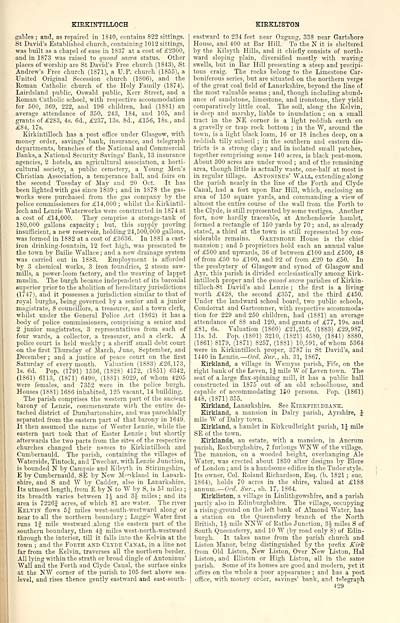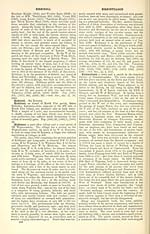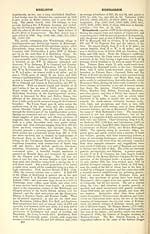Ordnance gazetteer of Scotland > Volume 4
(215) Page 429
Download files
Complete book:
Individual page:
Thumbnail gallery: Grid view | List view

KIRKINTILLOCH
gables ; and, as repaired in 1840, contains 822 sittings.
St David's Established church, containing 1012 sittings,
was built as a chapel of ease in 1837 at a cost of £2300,
and in 1S73 was raised to quoad sacra status. Other
places of worship are St David's Free church (1843), St
Andrew's Free church (1871), a U.P. church (1855), a
United Original Secession church (1806), and the
Roman Catholic church of the Holy Family (1874).
Lairdsland public, Oswald public, Kerr Street, and a
Roman Catholic school, with respective accommodation
for 500, 369, 222, and 196 children, had (1881) an
average attendance of 350, 243, 184, and 105, and
grants of £283, 4s. 6d., £237, 13s. 8d., £156, 18s., and
£84, 17s.
Kirkintilloch has a post office under Glasgow, with
money order, savings' bank, insurance, and telegraph
departments, branches of the National and Commercial
Banks, a National Security Savings' Bank, 13 insurance
agencies, 2 hotels, an agricultural association, a horti-
cultural society, a public cemetery, a Young Men's
Christian Association, a temperance hall, and fairs on
the second Tuesday of May and 20 Oct. It has
been lighted with gas since 1839 ; and in 1S78 the gas-
works were purchased from the gas company by the
police commissioners for £14,000 ; whilst the Kirkintil-
loch and Lenzie Waterworks were constructed in 1S74 at
a cost of £14,000. They comprise a storage-tank of
180,000 gallons capacity ; but, this supply proving
insufficient, a new reservoir, holding 24,500,000 gallons,
was formed in 1882 at a cost of £3636. In 1881 a cast-
iron drinking-fountain, 12 feet high, was presented to
the town by Bailie Wallace ; and a new drainage system
was carried out in 1883. Employment is afforded
by 3 chemical works, 3 iron foundries, 2 steam saw-
mills, a power-loom factory, and the weaving of lappet
muslin. The burgh became independent of its baronial
superior prior to the abolition of hereditary jurisdictions
(1747), and it possesses a jurisdiction similar to that of
royal burghs, being governed by a senior and a junior
magistrate, 8 councillors, a treasurer, and a town clerk,
whilst under the General Police Act (1862) it has a
body of police commissioners, comprising a senior and
2 junior magistrates, 3 representatives from each of
four wards, a collector, a treasurer, and a clerk. A
police court is held weekly ; a sheriff small debt court
on the first Thursday of March, June, September, and
December ; and a justice of peace court on the first
Saturday of everv month. Valuation (1883) £26,173,
Is. 6d. Pop. (1791) 1536, (1828) 4172, (1851) 6342,
(1861) 6113, (1871) 6490, (1881) 8029, of whom 4205
were females, and 7352 were in the police burgh.
Houses (1881) 16S6 inhabited, 125 vacant, 14 building.
The parish comprises the western part of the ancient
barony of Lenzie, commensurate with the entire de-
tached district of Dumbartonshire, and was parochially
separated from the eastern part of that barony in 1649.
It then assumed the name of Wester Lenzie, while the
eastern part took that of Easter Lenzie ; but shortly
afterwards the two parts from the sites of the respective
churches changed their names to Kirkintilloch and
Cumbernauld. The parish, containing the villages of
Waterside, Tintock, and Twechar, with Lenzie Junction,
is bounded N by Campsie and Kilsyth in Stirlingshire,
E by Cumbernauld, SE by New Monkland in Lanark-
shire, and S and W by Cadder, also in Lanarkshire.
Its utmost length, from E by N to W by S, is 51 miles ;
its breadth varies between 1| and 3£ miles; and its
area is 7226| acres, of which 81 are water. The river
Kelvin flows 5f miles west-south-westward along or
near to all the northern boundary ; Luggi«- Water first
runs If mile westward along the eastern part of the
southern boundary, then 4§ miles west-north-westward
through the interior, till it falls into the Kelvin at the
town ; and the Forth and Clyde Canal, in a line not
far from the Kelvin, traverses all the northern border.
Al l lying within the strath or broad dingle of Antoninus'
Wall and the Forth and Clyde Canal, the surface sinks
at the NW corner of the parish to 105 feet above sea-
level, and rises thence gently eastward and east-sonth-
KIRKLISTON
eastward to 234 feet near Oxgang, 33S near Gartshoro
House, and 400 at Bar Hill. To the N it is sheltered
by the Kilsyth Hills, and it chiefly consists of north-
ward sloping plain, diversified mostly with waving
swells, but in Bar Hill presenting a steep and precipi-
tous craig. The rocks belong to the Limestone Car-
boniferous series, but are situated on the northern verge
of the great coal field of Lanarkshire, beyond the line of
the most valuable seams ; and, though including abund-
ance of sandstone, limestone, and ironstone, they yield
comparatively little coal. The soil, along the Kelvin,
is deep and marshy, liable to inundation ; on a small
tract in the NE corner is a light reddish earth on
a gravelly or trap rock bottom ; in the W, around the
town, is a light black loam, 16 or 18 inches deep, on a
reddish tilly subsoil ; in the southern and eastern dis-
tricts is a strong clay ; and in isolated small patches,
together comprising some 140 acres, is black peat-moss.
About 300 acres are under wood ; and of the remaining
area, though little is actually waste, one-half at most is
in regular tillage. Antoninus' Wall, extending along
the parish nearly in the line of the Forth and Clyde
Canal, had a fort upon Bar Hill, which, enclosing an
area of 150 square yards, and commanding a view of
almost the entire course of the wall from the Forth to
the Clyde, is still represented by some vestiges. Another
fort, now hardly traceable, at Auchendowie hamlet,
formed a rectangle of 150 yards by 70 ; and, as already
stated, a third at the town is still represented by con-
siderable remains. Gartshoee House is the chief
mansion ; and 5 proprietors hold each an annual value
of £500 and upwards, 36 of between £100 and £500, 48
of from £50 to £100, and 92 of from £20 to £50. In
the presbytery of Glasgow and synod of Glasgow and
Ayr, this parish is divided ecclesiastically among Kirk-
intilloch proper and the quoad sacra parishes of Kirkin-
tilloch-St David's and Lenzie ; the first is a living
worth £428, the second £357, and the third £450.
Under the landward school board, two public schools,
Condorrat and Gartconner, with respective accommoda-
tion for 229 and 250 children, had (1881) an average
attendance of 88 and 120, and grants of £77, 19s. and
£81, 6s. Valuation (I860) £21,216, (1883) £29,987,
lis. Id. Pop. (1801) 3210, (1821) 4580, (1841) 8880,
(1861)8179, (1871) 8257, (1881) 10,591, of whom 5364
were in Kirkintilloch proper, 3787 in St David's, and
1440 in Lenzie.— Ord. Swr., sh. 31, 1867.
Kirkland, a village in Wemyss parish, Fife, on the
right bank of the Leven, 1 J mile W of Leven town. The
seat of a large flax-spinning mill, it has a public hall
constructed in 1875 out of an old schoolhouse, and
capable of accommodating 160 persons. Pop. (1861)
448, (1871) 355.
Kirkland, Lanarkshire. See Kirkfieldbanx.
Kirkland, a mansion in Dairy parish, Ayrshire, J
mile W of Dairy town.
Kirkland, a hamlet in Kirkcudbright parish, 1J mile
SE of the town.
Kirklands, an estate, with a mansion, in Ancrum
parish, Roxburghshire, 7 furlongs WNW of the village.
The mansion, on a wooded height, overhanging Ale
Water, was erected about 1830 after designs by Blore
of London ; and is a handsome edifice in the Tudor style.
Its owner, Col. Roland Richardson, Esq. (b. 1821 ; sue.
1864), holds 70 acres in the shire, valued at £188
annum. — Ord. Sur., sh. 17, 1864.
Kirkliston, a village in Linlithgowshire, and a parish
partly also in Edinburghshire. The village, occupying
a rising-ground on the left bank of Almond Water, has
a station on the Queensferry branch of the North
British, 14 mile NNW of Ratho Junction, 3i miles S of
South Queensferry, and 10 W (by road only 8) of Edin-
burgh. It takes name from the parish church and
Liston Manor, being distinguished by the prefix Kirk
from Old Liston, New Liston, Over New Liston, Hal
Liston, and Illiston or High Liston, all in the same
parish. Some of its houses are good and modern, yet it
offers on the whole a poor appearance ; and has a post
office, with money order, saving's' bank, and telegraph
429
gables ; and, as repaired in 1840, contains 822 sittings.
St David's Established church, containing 1012 sittings,
was built as a chapel of ease in 1837 at a cost of £2300,
and in 1S73 was raised to quoad sacra status. Other
places of worship are St David's Free church (1843), St
Andrew's Free church (1871), a U.P. church (1855), a
United Original Secession church (1806), and the
Roman Catholic church of the Holy Family (1874).
Lairdsland public, Oswald public, Kerr Street, and a
Roman Catholic school, with respective accommodation
for 500, 369, 222, and 196 children, had (1881) an
average attendance of 350, 243, 184, and 105, and
grants of £283, 4s. 6d., £237, 13s. 8d., £156, 18s., and
£84, 17s.
Kirkintilloch has a post office under Glasgow, with
money order, savings' bank, insurance, and telegraph
departments, branches of the National and Commercial
Banks, a National Security Savings' Bank, 13 insurance
agencies, 2 hotels, an agricultural association, a horti-
cultural society, a public cemetery, a Young Men's
Christian Association, a temperance hall, and fairs on
the second Tuesday of May and 20 Oct. It has
been lighted with gas since 1839 ; and in 1S78 the gas-
works were purchased from the gas company by the
police commissioners for £14,000 ; whilst the Kirkintil-
loch and Lenzie Waterworks were constructed in 1S74 at
a cost of £14,000. They comprise a storage-tank of
180,000 gallons capacity ; but, this supply proving
insufficient, a new reservoir, holding 24,500,000 gallons,
was formed in 1882 at a cost of £3636. In 1881 a cast-
iron drinking-fountain, 12 feet high, was presented to
the town by Bailie Wallace ; and a new drainage system
was carried out in 1883. Employment is afforded
by 3 chemical works, 3 iron foundries, 2 steam saw-
mills, a power-loom factory, and the weaving of lappet
muslin. The burgh became independent of its baronial
superior prior to the abolition of hereditary jurisdictions
(1747), and it possesses a jurisdiction similar to that of
royal burghs, being governed by a senior and a junior
magistrate, 8 councillors, a treasurer, and a town clerk,
whilst under the General Police Act (1862) it has a
body of police commissioners, comprising a senior and
2 junior magistrates, 3 representatives from each of
four wards, a collector, a treasurer, and a clerk. A
police court is held weekly ; a sheriff small debt court
on the first Thursday of March, June, September, and
December ; and a justice of peace court on the first
Saturday of everv month. Valuation (1883) £26,173,
Is. 6d. Pop. (1791) 1536, (1828) 4172, (1851) 6342,
(1861) 6113, (1871) 6490, (1881) 8029, of whom 4205
were females, and 7352 were in the police burgh.
Houses (1881) 16S6 inhabited, 125 vacant, 14 building.
The parish comprises the western part of the ancient
barony of Lenzie, commensurate with the entire de-
tached district of Dumbartonshire, and was parochially
separated from the eastern part of that barony in 1649.
It then assumed the name of Wester Lenzie, while the
eastern part took that of Easter Lenzie ; but shortly
afterwards the two parts from the sites of the respective
churches changed their names to Kirkintilloch and
Cumbernauld. The parish, containing the villages of
Waterside, Tintock, and Twechar, with Lenzie Junction,
is bounded N by Campsie and Kilsyth in Stirlingshire,
E by Cumbernauld, SE by New Monkland in Lanark-
shire, and S and W by Cadder, also in Lanarkshire.
Its utmost length, from E by N to W by S, is 51 miles ;
its breadth varies between 1| and 3£ miles; and its
area is 7226| acres, of which 81 are water. The river
Kelvin flows 5f miles west-south-westward along or
near to all the northern boundary ; Luggi«- Water first
runs If mile westward along the eastern part of the
southern boundary, then 4§ miles west-north-westward
through the interior, till it falls into the Kelvin at the
town ; and the Forth and Clyde Canal, in a line not
far from the Kelvin, traverses all the northern border.
Al l lying within the strath or broad dingle of Antoninus'
Wall and the Forth and Clyde Canal, the surface sinks
at the NW corner of the parish to 105 feet above sea-
level, and rises thence gently eastward and east-sonth-
KIRKLISTON
eastward to 234 feet near Oxgang, 33S near Gartshoro
House, and 400 at Bar Hill. To the N it is sheltered
by the Kilsyth Hills, and it chiefly consists of north-
ward sloping plain, diversified mostly with waving
swells, but in Bar Hill presenting a steep and precipi-
tous craig. The rocks belong to the Limestone Car-
boniferous series, but are situated on the northern verge
of the great coal field of Lanarkshire, beyond the line of
the most valuable seams ; and, though including abund-
ance of sandstone, limestone, and ironstone, they yield
comparatively little coal. The soil, along the Kelvin,
is deep and marshy, liable to inundation ; on a small
tract in the NE corner is a light reddish earth on
a gravelly or trap rock bottom ; in the W, around the
town, is a light black loam, 16 or 18 inches deep, on a
reddish tilly subsoil ; in the southern and eastern dis-
tricts is a strong clay ; and in isolated small patches,
together comprising some 140 acres, is black peat-moss.
About 300 acres are under wood ; and of the remaining
area, though little is actually waste, one-half at most is
in regular tillage. Antoninus' Wall, extending along
the parish nearly in the line of the Forth and Clyde
Canal, had a fort upon Bar Hill, which, enclosing an
area of 150 square yards, and commanding a view of
almost the entire course of the wall from the Forth to
the Clyde, is still represented by some vestiges. Another
fort, now hardly traceable, at Auchendowie hamlet,
formed a rectangle of 150 yards by 70 ; and, as already
stated, a third at the town is still represented by con-
siderable remains. Gartshoee House is the chief
mansion ; and 5 proprietors hold each an annual value
of £500 and upwards, 36 of between £100 and £500, 48
of from £50 to £100, and 92 of from £20 to £50. In
the presbytery of Glasgow and synod of Glasgow and
Ayr, this parish is divided ecclesiastically among Kirk-
intilloch proper and the quoad sacra parishes of Kirkin-
tilloch-St David's and Lenzie ; the first is a living
worth £428, the second £357, and the third £450.
Under the landward school board, two public schools,
Condorrat and Gartconner, with respective accommoda-
tion for 229 and 250 children, had (1881) an average
attendance of 88 and 120, and grants of £77, 19s. and
£81, 6s. Valuation (I860) £21,216, (1883) £29,987,
lis. Id. Pop. (1801) 3210, (1821) 4580, (1841) 8880,
(1861)8179, (1871) 8257, (1881) 10,591, of whom 5364
were in Kirkintilloch proper, 3787 in St David's, and
1440 in Lenzie.— Ord. Swr., sh. 31, 1867.
Kirkland, a village in Wemyss parish, Fife, on the
right bank of the Leven, 1 J mile W of Leven town. The
seat of a large flax-spinning mill, it has a public hall
constructed in 1875 out of an old schoolhouse, and
capable of accommodating 160 persons. Pop. (1861)
448, (1871) 355.
Kirkland, Lanarkshire. See Kirkfieldbanx.
Kirkland, a mansion in Dairy parish, Ayrshire, J
mile W of Dairy town.
Kirkland, a hamlet in Kirkcudbright parish, 1J mile
SE of the town.
Kirklands, an estate, with a mansion, in Ancrum
parish, Roxburghshire, 7 furlongs WNW of the village.
The mansion, on a wooded height, overhanging Ale
Water, was erected about 1830 after designs by Blore
of London ; and is a handsome edifice in the Tudor style.
Its owner, Col. Roland Richardson, Esq. (b. 1821 ; sue.
1864), holds 70 acres in the shire, valued at £188
annum. — Ord. Sur., sh. 17, 1864.
Kirkliston, a village in Linlithgowshire, and a parish
partly also in Edinburghshire. The village, occupying
a rising-ground on the left bank of Almond Water, has
a station on the Queensferry branch of the North
British, 14 mile NNW of Ratho Junction, 3i miles S of
South Queensferry, and 10 W (by road only 8) of Edin-
burgh. It takes name from the parish church and
Liston Manor, being distinguished by the prefix Kirk
from Old Liston, New Liston, Over New Liston, Hal
Liston, and Illiston or High Liston, all in the same
parish. Some of its houses are good and modern, yet it
offers on the whole a poor appearance ; and has a post
office, with money order, saving's' bank, and telegraph
429
Set display mode to: Large image | Transcription
Images and transcriptions on this page, including medium image downloads, may be used under the Creative Commons Attribution 4.0 International Licence unless otherwise stated. ![]()
| Gazetteers of Scotland, 1803-1901 > Ordnance gazetteer of Scotland > Volume 4 > (215) Page 429 |
|---|
| Permanent URL | https://digital.nls.uk/97382926 |
|---|
| Attribution and copyright: |
|
|---|---|

